- 1. Key Takeaways
- 2. Making a Backpacking Checklist
- 3. Backpacking Essentials and Emergency Gear
- 3.1. Backpack
- 3.2. Tent
- 3.3. Sleeping Bag
- 3.4. Sleeping Pad
- 3.5. Water Filter
- 3.6. First Aid Kit
- 3.7. Fire Starting
- 4. Backpacking Tools, Equipment, and Accessories
- 4.1. Headlamp
- 4.2. Multi-tool or Knife
- 4.3. Foldable Shovel or a Trowel
- 4.4. Paracord
- 4.5. Repair Kit
- 4.6. Trekking Poles
- 4.7. Portable Charger
- 4.8. Pillow
- 4.9. Tarp
- 4.10. Folding Saw
- 4.11. Weather Gear
- 5. Backpacking Clothing and Footwear
- 5.1. Spring/Summer
- 5.2. Fall/Winter
- 5.3. Layering: The Golden Rule
- 5.4. Material Matters
- 6. Backpacking Hygiene and Health
- 6.1. Toothbrush and Toothpaste
- 6.2. Hand Sanitizer
- 6.3. Biodegradable Wipes
- 6.4. Toilet Paper
- 6.5. Prescription Medication
- 6.6. Sunscreen
- 6.7. Bug Repellent
- 6.8. Ziploc Bags
- 7. Backpacking Navigation and Safety
- 7.1. Maps and Compass
- 7.2. GPS Device
- 7.3. Emergency Whistle
- 7.4. Emergency Blanket
- 7.5. Personal Locator Beacon
- 7.6. Bear Spray
- 8. Backpacking Kitchen Gear and Cookware
- 8.1. Portable Stove
- 8.2. Stove Fuel
- 8.3. Cookware
- 8.4. Reusable Utensils
- 8.5. Food Storage
- 8.6. Water Bottles
- 8.7. Cleaning Supplies
- 8.8. Knife
- 9. Backpacking Food and Drink
- 9.1. Non-perishable Foods
- 9.2. Cookable Foods
- 9.3. Drinks
- 9.4. Snacks
- 9.5. Water
- 10. Extra Backpacking Must-Haves
- 10.1. Notebook and Pen
- 10.2. Entertainment
- 10.3. Cash
- 10.4. Spare Batteries
- 10.5. Zip Ties and Duct Tape
- 10.6. Camera Gear
- 10.7. Fishing Gear
- 10.8. Binoculars
- 10.9. Personal Items
- 10.10. Field Guide
- 11. Tips for Planning Your Backpacking Trip
- 12. Final Thoughts
- 13. FAQs
- 13.1. How much food do you need for 3 days backpacking?
- 13.2. Is 7 kg enough for backpacking?
- 13.3. What I wish I knew before backpacking?
- 13.4. How hard is it to backpack through Europe?
- 13.5. Does backpacking build muscle?
- 13.6. How much cash should I take backpacking?
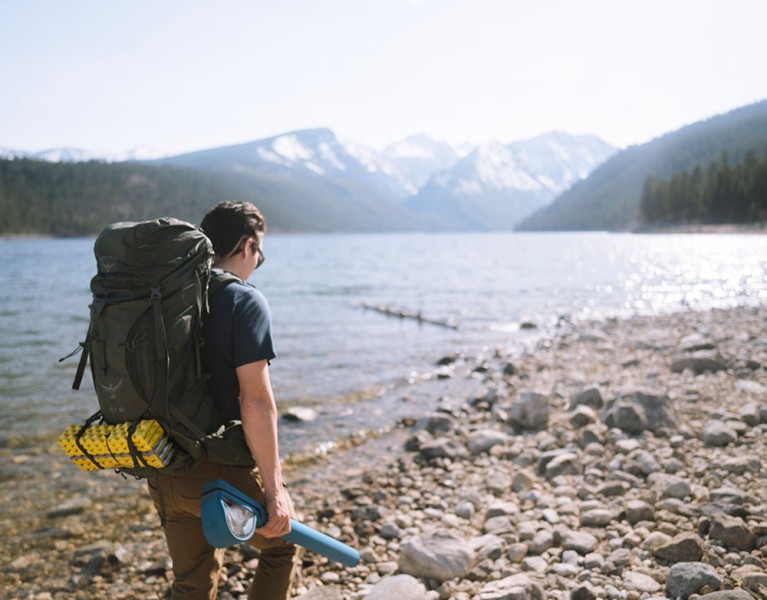
KÜHL’s Backpacking Checklist: Tips on Gear and Essentials
Table of Contents [Show]
Setting out with nothing but what you can carry on your back is the essence of backpacking. It's a practice in minimalism, a test of resourcefulness and, above all, an invitation to connect with the natural world in a way that's deeply personal. Meticulous planning and the right gear are your tickets to not just surviving, but thriving in the great outdoors.
A well-crafted backpacking checklist is your silent companion, ensuring you're prepared for whatever adventures—or challenges—the trail has in store. This guide aims to provide you with an extensive list of backpacking necessities, lightweight gear, and tips to ensure your next outdoor adventure is safe, enjoyable and unforgettable.
Key Takeaways
- Comprehensive Backpacking Gear Checklist: From the best backpacking gear to the smallest accessories, this guide covers everything you'll need for your trip.
- Seasonal Clothing Guide: Learn how to adapt your clothing choices for different seasons, including our recommendations for hiking outfits for summer.
- Health and Hygiene: Don't overlook the importance of personal care items. We'll guide you through the backpacking essentials for maintaining hygiene and health.
- Food and Nutrition: What you eat on the trail matters. Get insights into what to bring on the trail to keep you energized.
- Safety and Navigation: Equip yourself with the necessary tools and knowledge for safe navigation through the wilderness.
Making a Backpacking Checklist
Creating a backpacking list is more than just jotting down items you think you'll need, it's a strategic approach to ensuring you're well-prepared for your outdoor adventure. A well-thought-out list helps you prioritize must-have ultralight backpacking gear, minimize weight and maximize utility.
A backpacking checklist acts as a safeguard against forgetting critical items like medication, maps or emergency gear. Whether you're planning day hikes or an extended trip, a checklist is an invaluable tool for a successful and enjoyable experience.
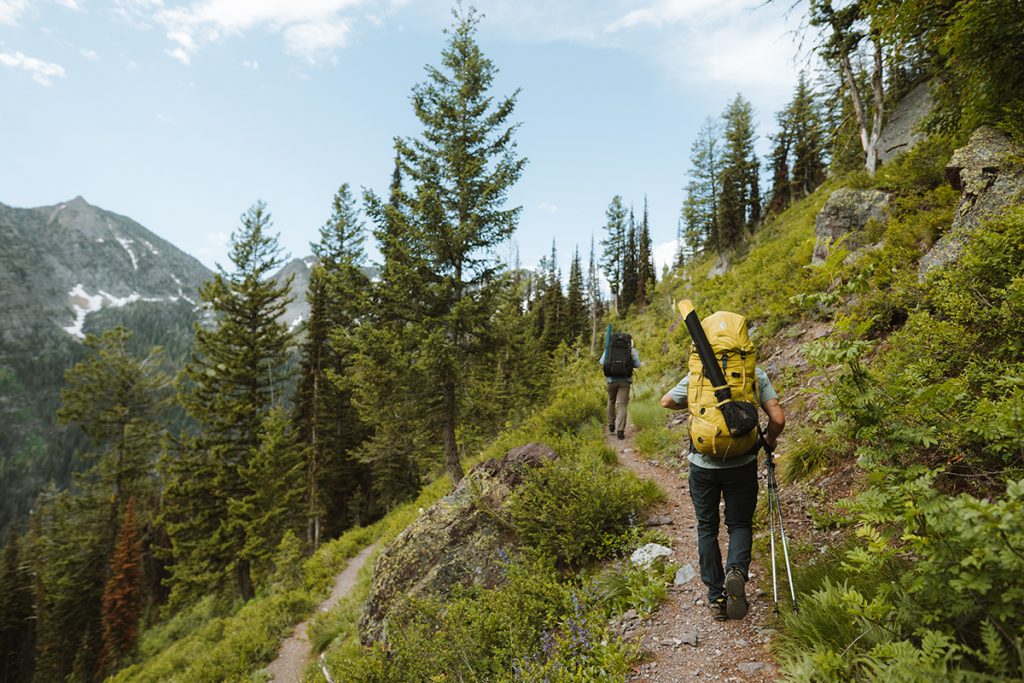
Backpacking Essentials and Emergency Gear
Backpack
Choosing the right backpack is crucial for a comfortable and successful backpacking trip. Look for a pack that has adjustable straps, multiple compartments and a padded hip belt to distribute weight evenly. The ideal size is between 40-60L, which should accommodate all your backpacking gear. Some packs come with built-in hydration reservoir sleeves, making it easier to stay hydrated.
Tent
Your tent is your home away from home, so it should be lightweight, durable, and easy to set up. Consider a tent with a quick setup design and one that offers good ventilation. The tent should also be weather-appropriate, offering adequate protection against rain, wind and potentially snow. This is a key component of your backpacking equipment.
Sleeping Bag
A quality sleeping bag is non-negotiable. Go for a bag that suits the season and weather conditions you'll be encountering. Look for features like a draft collar, hood and zipper baffles to keep you warm. Synthetic or down are the two main types of insulation, each with its pros and cons.
Sleeping Pad
A sleeping pad not only provides comfort but also insulates you from the cold ground. Choose between foam pads, self-inflating pads, or inflatable pads based on your comfort needs and pack space. Make sure it fits well within your tent and sleeping bag.
Water Filter
Access to clean water is vital. A portable water filter can be a lifesaver in the backcountry. There are various types, including pump filters, squeeze filters and UV purifiers. Note: always test it out before taking a brand new filter on a backpacking trip!
First Aid Kit
A first aid kit should be tailored to your needs but generally should include bandages, antiseptics, tweezers and pain relievers. It's also wise to include any personal medication you may need. For a more comprehensive list of items, check out our first-aid checklist.
Fire Starting
For fire-starting, pack waterproof matches, a firestarter and a windproof lighter. Waterproof matches offer reliability in all weather, while firestarters like magnesium rods or cubes can quickly ignite a fire even in damp conditions. A windproof butane lighter serves as a reusable option. These backpacking must-haves will help keep you warm, help you cook and aid in emergencies.
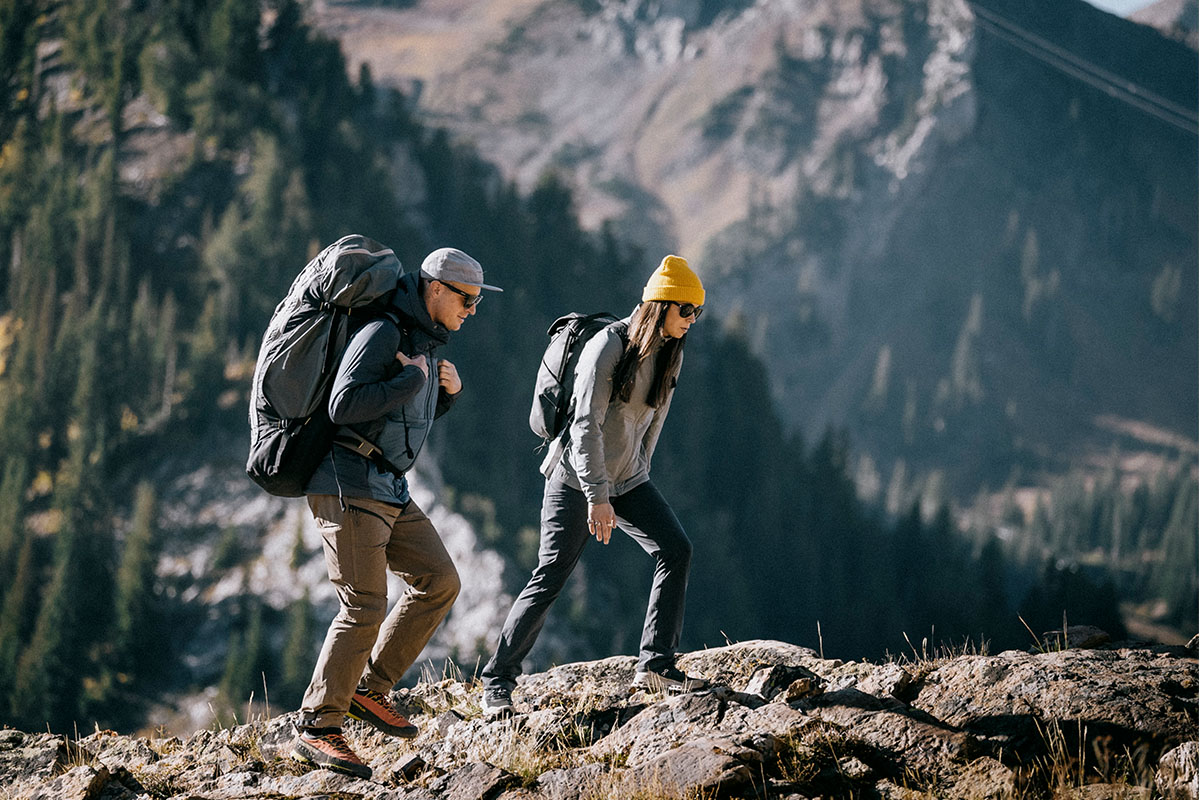
Backpacking Tools, Equipment, and Accessories
Headlamp
A reliable headlamp is crucial for navigating in the dark and for emergency situations. You could also bring a small flashlight, but a headlamp is almost always more convenient.
Multi-tool or Knife
A versatile multi-tool can serve various purposes, from cutting to repairs. If you don’t bring a multi-tool you’ll need to bring a knife. This serves multiple purposes, from food preparation and cutting cordage to emergency situations like first aid. A good, sharp knife can also be used for making kindling or shaving wood for a firestarter. Opt for a versatile, high-quality knife that is both lightweight and durable.
Foldable Shovel or a Trowel
Shovels will help you greatly when you need to use the forest as a restroom. It’s always important to dig a 6-8 inch hole for your business; that’s where a shovel comes in handy. Foldable shovels are typically lightweight, but an even better tool would be a trowel, or a small gardening shovel.
Paracord
Paracord is a lightweight, durable nylon rope essential for any backpacking trip. It's useful for setting up tarps, hanging food, and emergency repairs. Known for its high tensile strength, it's a versatile item that takes up minimal space in your pack.
Repair Kit
A repair kit is a must-have for any backpacking trip. It should include items like duct tape, sewing needles, safety pins, and multi-tool with pliers and a knife. This kit can be a lifesaver for fixing torn gear, broken zippers, or punctured sleeping pads.
Trekking Poles
These poles offer stability on uneven terrain and can double as tent poles for specific ultralight tents.
Portable Charger
Keep your devices charged with a solar-powered or battery-operated portable charger.
Pillow
While some backpackers use bundled-up clothing as a pillow, a specialized backpacking pillow can offer better neck support and comfort. These pillows are usually inflatable or compressible and take up minimal space in your pack.
Tarp
A tarp is a versatile piece of gear that can serve multiple purposes. It can act as an additional layer under your tent for extra waterproofing, or be rigged up as a makeshift shelter or rain cover. Opt for a lightweight, durable material like ripstop nylon.
Folding Saw
A folding saw is an excellent tool for backpackers who need to cut wood for campfires or shelter but want to keep their pack weight down. Unlike a hatchet, which can be heavy and cumbersome, a folding saw is lightweight and takes up less space. Its sharp teeth can efficiently cut through branches and small logs, making it a practical choice for those looking to minimize their gear weight without sacrificing utility.
Weather Gear
Always pack a rain jacket and consider other weather-specific items. For more about the right rain gear to pack, check our guide on how to stay safe and dry while hiking in the rain.
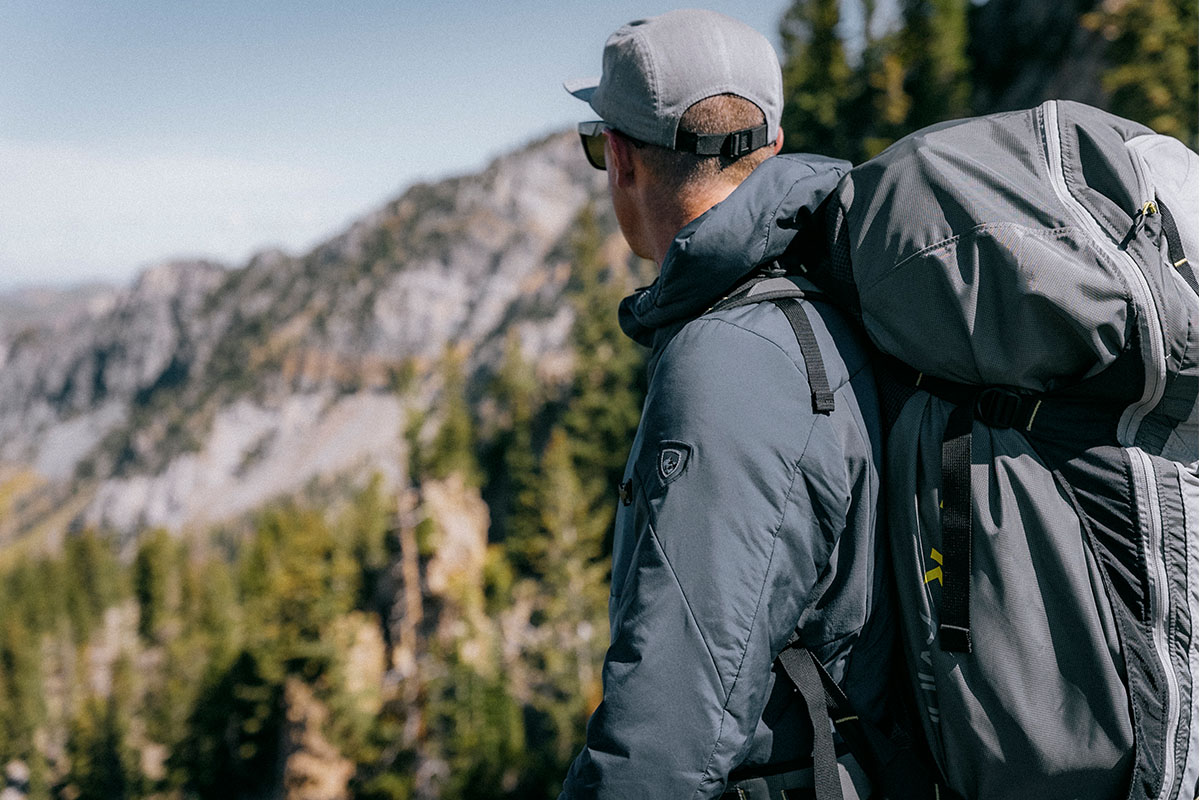
Backpacking Clothing and Footwear
Selecting the right clothing and footwear for your backpacking trip is important for both comfort and safety. The goal is to choose fabrics that are lightweight, breathable and quick-drying. Layering is a key strategy that allows you to adapt to changing weather conditions. For more detailed advice, check out KÜHL's guides on hiking outfits for summer and outdoor clothing.
Spring/Summer
Base Layer
During the warmer months, your base layer should be made of moisture-wicking materials like merino wool or synthetic blends. These fabrics pull sweat away from your skin, keeping you dry and reducing the risk of chafing.
Mid-Layer
Even in summer, temperatures can drop, especially at higher elevations. A lightweight fleece or synthetic jacket can provide just the right amount of warmth without causing overheating. Look for jackets with zippered vents for added breathability.
Outer Layer
A breathable, water-resistant shell jacket is essential for those unexpected rain showers or windy conditions. Opt for jackets with adjustable hoods and cuffs to keep the elements at bay.
Pants
When it comes to pants you’ll want something lightweight, flexible, and breathable as you’ll be moving around a lot. Try to stay away from something like jeans as these can be heavy, and made of cotton which is usually a hassle to dry once wet.
Footwear
Ventilated hiking boots or trail running shoes are ideal for summer day hikes. Make sure they offer good ankle support and have a grippy sole for varied terrain.
Accessories
Don't forget a wide-brimmed hat for sun protection, lightweight gloves for cooler mornings, and moisture-wicking socks to keep your feet dry. Sunglasses with UV protection are also a must.
Fall/Winter
Base Layer
In colder weather, opt for thermal, moisture-wicking fabrics that can keep you warm even when wet. A long-sleeve Merino wool is an excellent choice for colder conditions due to its natural temperature-regulating properties.
Mid-Layer
A heavier fleece or down jacket is essential for insulation. Some jackets come with removable inner layers, allowing you to adjust your level of warmth as needed.
Outer Layer
An insulated, waterproof, and windproof jacket is non-negotiable for winter backpacking. Look for features like sealed seams, storm flaps over zippers, and adjustable hoods that can fit over a beanie or helmet.
Pants
When you’re thinking about pants to wear during colder months you may want to have a pair of long underwear along with lightweight pants over them, or pants that have a comfy lining to keep your legs warm.
Footwear
Insulated, waterproof hiking boots are a must. Look for boots with a high ankle for better support and choose a pair with removable liners for easy drying.
Accessories
Thermal hiking socks, a warm beanie, insulated gloves, and even a neck gaiter can make a significant difference in keeping you warm. Always carry an extra pair of gloves and hiking socks in case the ones you're wearing get wet.
Layering: The Golden Rule
The key to dressing for backpacking in any season is layering. Layering allows you to easily add or remove clothing to adapt to changing weather conditions and activity levels. Always start with a good base layer that wicks moisture away, followed by an insulating mid-layer, and finally, an outer layer that protects against wind and rain.
Material Matters
When choosing clothing, pay attention to the material. Synthetic materials like polyester are generally more breathable and wick moisture better than cotton, which can become heavy and uncomfortable when wet. Merino wool is another excellent material that provides both moisture-wicking and temperature regulation. KÜHL offers a wide range of men's outdoor wear and women's hiking clothing specifically designed for high-performance activities.
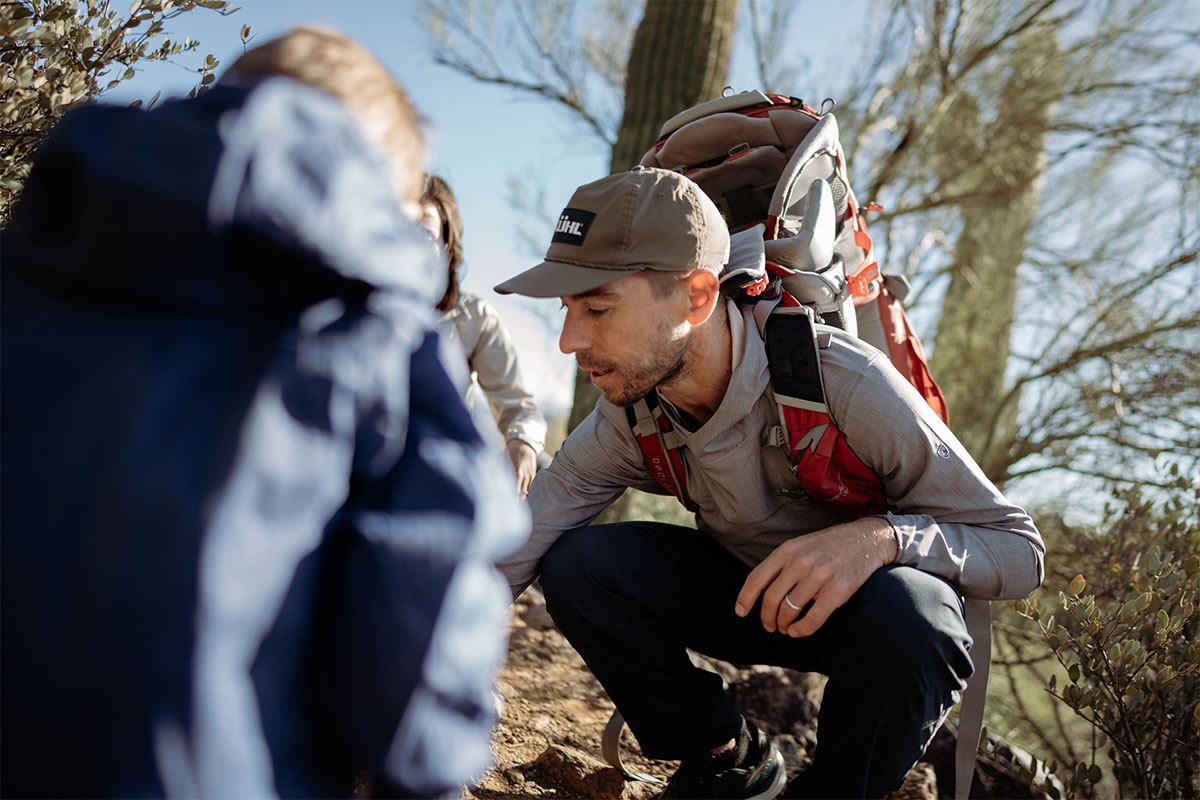
Backpacking Hygiene and Health
Maintaining good hygiene while backpacking is not only essential for your well-being but also crucial for preserving the natural environment. It's important to pack out all used toilet paper and other hygiene products to leave no trace. When nature calls, dig a cat hole at least 6 to 8 inches deep and at least 200 feet away from water sources to minimize the risk of water contamination. Here’s some items you’ll want to add to your backpacking kit.
Toothbrush and Toothpaste
Oral hygiene is just as important on the trail as it is at home.
Hand Sanitizer
A small bottle can go a long way in maintaining hygiene.
Biodegradable Wipes
For quick clean-ups when water is scarce.
Toilet Paper
Opt for a biodegradable type and remember to pack out what you pack in.
Prescription Medication
Don't forget any personal medications you may need.
Sunscreen
Protect your skin from harmful UV rays.
Bug Repellent
Insect repellents are especially important in wooded or areas near water.
Ziploc Bags
You should add at least two large ziploc bags to your backpacking pack list. One to store used toilet paper, and the other for trash that you create or trash found along the trail.
Backpacking Navigation and Safety
Never underestimate the importance of navigation tools. A physical map and compass are reliable basics, but a GPS device can also be invaluable, especially when dispersed camping. Make sure you know how to use these tools effectively. You should also let a trusted friend or relative know exactly where you plan on going before your trip. Here’s some backpacking supplies to think about.
Maps and Compass
These backpacking accessories are crucial for navigation, even if you have electronic devices.
GPS Device
A reliable GPS can be a lifesaver, but always have a backup.
Emergency Whistle
Useful for signaling for help.
Emergency Blanket
Lightweight and compact, it can be a lifesaver in cold conditions.
Personal Locator Beacon
In remote areas, this can be crucial for emergency rescues.
Bear Spray
This should only be thought about if you know for a fact you’ll be in brown bear country.
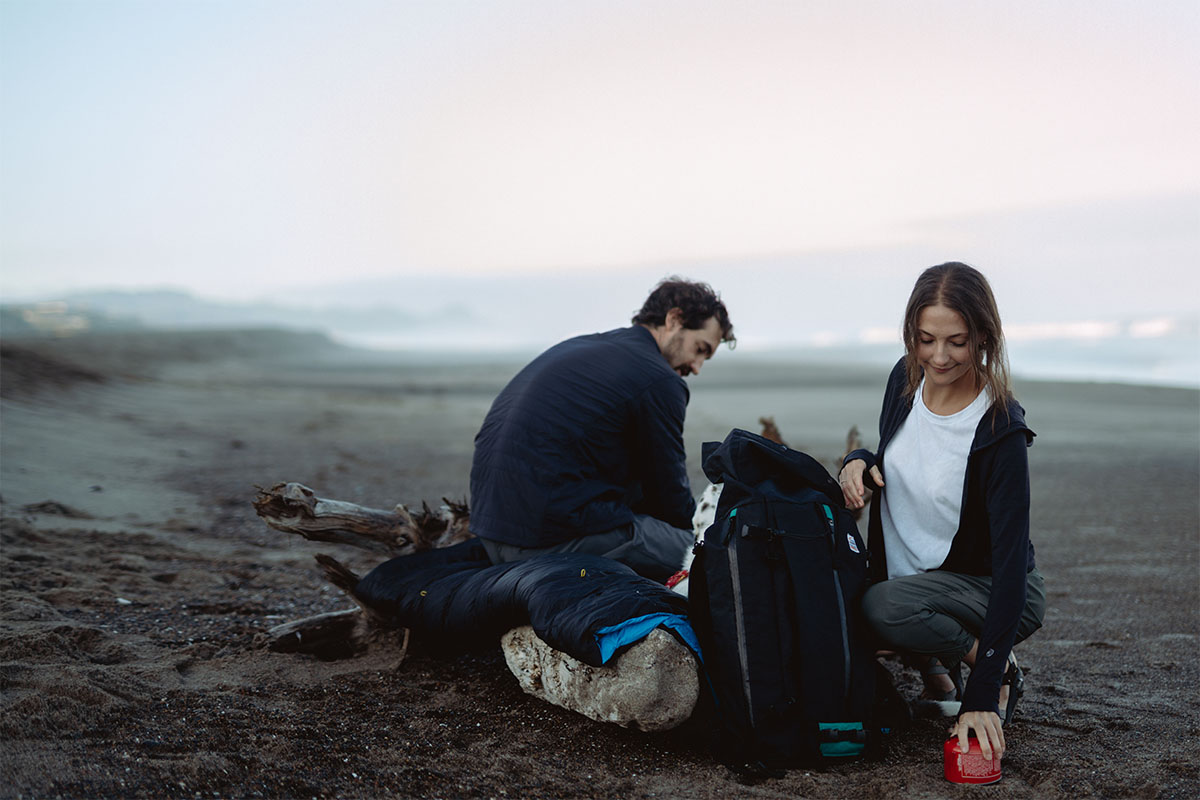
Backpacking Kitchen Gear and Cookware
There’s nothing better than enjoying a warm meal in the middle of the woods after a long hike. Here are some things to consider adding to your backpacking essentials list.
Portable Stove
A compact, fuel-efficient stove is a cornerstone for preparing hot meals in the backcountry. Whether you choose a canister or liquid fuel stove, make sure it's easy to operate and has a stable base for your cookware.
Stove Fuel
Stove fuel is a crucial item for powering your portable cooking stove during backpacking trips. The type of fuel required varies depending on the stove you have, with common options including isobutane-propane canisters, white gas, or alcohol.
Cookware
Your kitchen set should include a lightweight pot for boiling water and a pan for frying or sautéing. Some sets even nest together to save space. Opt for materials like titanium or anodized aluminum for durability and heat efficiency.
Reusable Utensils
Instead of disposable options, bring reusable utensils made of materials like titanium or bamboo. A spork can serve as both a spoon and a fork, reducing the number of items you need to carry.
Food Storage
To keep your food fresh and safe, use Ziploc bags or airtight containers. For extensive trips, you may also consider specialized camping food storage solutions like bear-resistant canisters, especially if you're traveling through areas where wildlife is prevalent.
Water Bottles
Staying hydrated is crucial, so bring durable water bottles or a hydration reservoir. Make sure they're easy to refill and fit securely in your pack's water bottle pockets.
Cleaning Supplies
A small sponge and a bottle of biodegradable soap are sufficient for cleaning your cookware. Remember to clean at least 200 feet away from water sources to minimize environmental impact.
Knife
All the backpacking gear for beginners out there will try and make you might think you need separate knives for cooking and other tasks. However, a single, versatile knife can serve multiple purposes, from food prep to emergency situations. Choose a folding knife with a sturdy blade and a secure lock for safety.
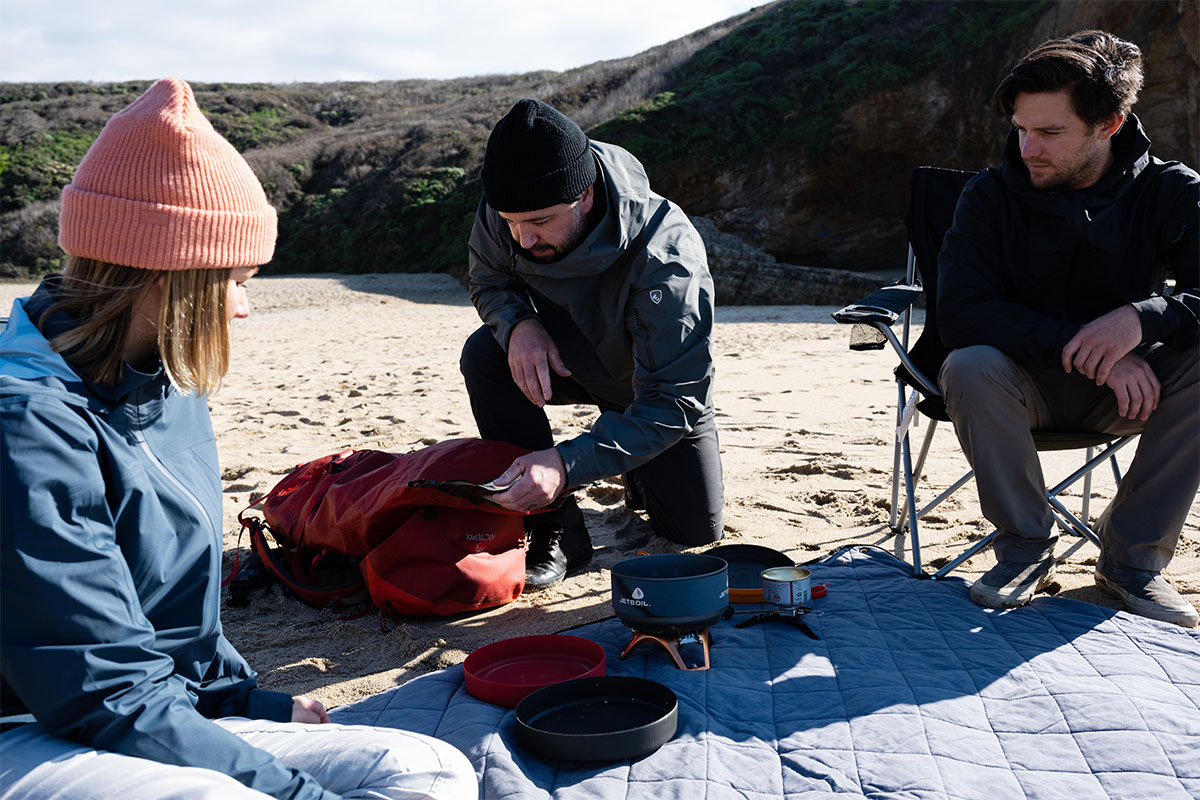
Backpacking Food and Drink
Non-perishable Foods
Items like trail mix, energy bars, and dried fruits are ideal for providing quick energy without the need for cooking. These are backpack essentials that should be in every pack.
Cookable Foods
Pack pasta, rice, or dehydrated meals that are easy to cook on a portable stove. These foods are not only lightweight but also satisfying, making them a smart choice for your backpacking gear list. For an in-depth look at backpacking meals, you can also refer to this list of hiking food tips and ideas.
Drinks
Bring along hydration tablets, coffee packets, or tea bags to add a touch of home comfort to your wilderness experience. These can easily be prepared with hot water from your portable stove.
Snacks
Include a variety of snacks like jerky, cheese sticks, or chocolate to keep your energy levels high throughout the day. For more snack inspiration check out these picnic ideas.
Water
When backpacking, it's crucial to carry enough water to last between refill points. Research your route to know where you can refill and plan to carry at least 3-4 liters of water per day, depending on the climate and your level of exertion.
Extra Backpacking Must-Haves
Not all of these extras can be considered essentials for backpacking, but they could easily make your trip that much more smooth. From relaxing escapes with a favorite book to playing a tune around the fire with a harmonica, these are some extra items to think about.
Notebook and Pen
Carrying a small notebook and pen can be incredibly useful. Whether you're jotting down trail notes, sketching the landscape or recording your thoughts, a notebook serves multiple purposes and adds little weight to your pack.
Entertainment
Long evenings in the wilderness can be filled with a good book, a deck of playing cards or even a compact musical instrument. A harmonica, for instance, is lightweight and can add a touch of music to your nights around the campfire.
Cash
It's wise to stash some emergency cash in a hidden compartment or waterproof bag. You never know when you might need it for park fees, a ride back to civilization, or other unforeseen expenses.
Spare Batteries
Always bring extra batteries for essential gear like your headlamp, GPS, or other battery-operated accessories. It's a small addition that can make a big difference in an emergency.
Zip Ties and Duct Tape
These are your go-to items for quick fixes on the trail. From mending a broken strap to patching up a tent tear, zip ties and duct tape are versatile tools that can save the day.
Camera Gear
If you're passionate about photography, consider packing a lightweight tripod or extra lenses. Just be mindful of the weight and ensure it fits comfortably in your backpack.
Fishing Gear
If your route takes you near lakes or rivers and you enjoy fishing, a compact, collapsible rod can add an exciting dimension to your trip. Just make sure you're aware of local fishing regulations.
Binoculars
Whether you're into birdwatching or just want to get a closer look at distant landscapes, a pair of compact binoculars can enhance your outdoor experience.
Personal Items
Don't forget any personal items you may need, such as prescription glasses, contact lenses, or specific medications. These may not be readily available in the wilderness, so plan ahead.
Field Guide
A pocket-sized field guide can be a fascinating companion on your backpacking trip. Whether you're interested in identifying edible plants, medicinal herbs, or simply learning about the local ecosystem, a well-illustrated guide can be both educational and potentially life-saving. Some guides are even tailored to specific regions, making them an excellent resource for local plant and animal identification.
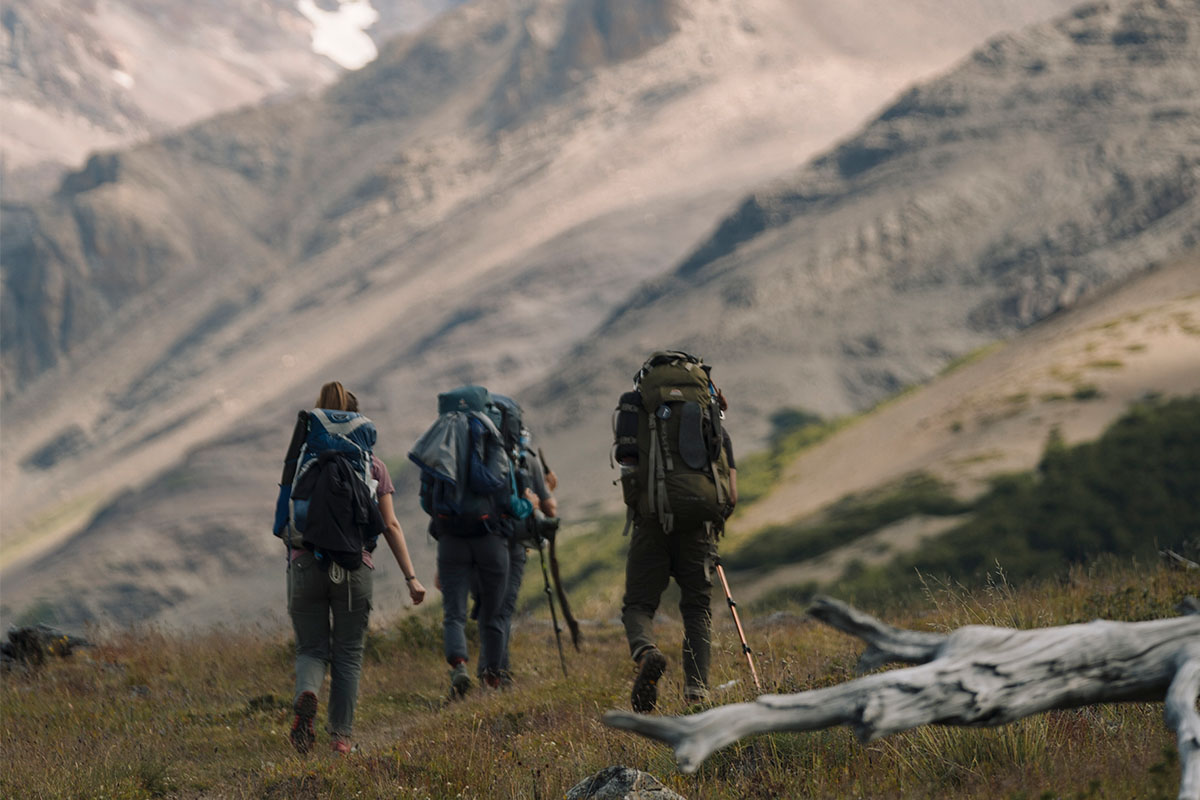
Tips for Planning Your Backpacking Trip
Planning a backpacking trip can be as exciting as the journey itself. However, it's crucial to be well-prepared for a safe experience. When deciding on what to bring backpacking, always think of the basics first – food, water, fire and shelter. Then once you’ve done some research on your destination you can create a more comprehensive backpacking packing list. Here are a few tips to help you out:
- Research Your Destination: Know the terrain, weather, and any potential hazards.
- Create a Checklist: Write all the gear you need on paper, this will help you stay organized.
- Check Regulations: Look into permits, campsite reservations, and any area-specific rules.
- Keep an Eye on the Weather: Always check the weather forecast to pack accordingly.
- Make Budget-Friendly Choices: Save on gear by considering second-hand items or rentals, and save on food by buying in bulk or DIY snacks by using a dehydrator.
- Have Emergency Contacts: Inform a trusted friend or family member about your itinerary and check-in regularly.
- Test Your Gear: Make sure all your equipment is in working condition before you leave.
- Practice Hiking: Before going on a grand backpacking adventure, take short hikes with all the lightweight gear you plan on bringing. A 2-3 hour hike will allow you to not only get adjusted to long hikes but help you understand if your pack is too heavy.
- Plan Your Meals: Think about your food needs and how you'll store and cook meals.
- Stay Flexible: Be prepared to adapt your plans for unexpected situations.
- Leave No Trace: Always clean up after yourself to preserve the environment for future adventurers.
For more tips on what to pack, you can refer to this camping checklist.
Final Thoughts
Backpacking is more than just a weekend getaway; it's an experience that can be both liberating and grounding. Whether you're a seasoned trail enthusiast or new to the world of outdoor adventures, the essence of a fulfilling experience lies in your preparedness. Crafting a comprehensive overnight backpacking list is not just a preparatory step, it's your roadmap to a successful and enjoyable journey.
Understanding what to pack for backpacking goes beyond the basics—it's about anticipating your needs in different scenarios, from unexpected weather changes to first-aid emergencies. This attention to detail not only enhances your connection with nature but also fosters responsible outdoor ethics. After all, nature is an indiscriminate host, and it's our collective responsibility to tread lightly and respectfully on its trails.
FAQs
How much food do you need for 3 days backpacking?
For a 3-day backpacking trip, you'll need approximately 2,500 to 4,500 calories per day, depending on your activity level. It's crucial to pack a balanced mix of carbohydrates, proteins, and fats to sustain energy levels.
Is 7 kg enough for backpacking?
Seven kilograms (about 15.4 pounds) may be sufficient for a short, summer trip where you can minimize clothing and gear. In colder climates, you might need more weight for additional clothing, food and gear.
What I wish I knew before backpacking?
One common regret is not investing in quality gear from the start. Comfortable, durable, and functional gear can make or break your experience. Also, practice more with their gear before the trip, learn basic first-aid, and understand the importance of proper food and water planning.
How hard is it to backpack through Europe?
Backpacking in Europe offers varying levels of difficulty depending on your itinerary and travel style; it is generally considered beginner-friendly due to its infrastructure, but challenges like language barriers and cost differences between Western and Eastern Europe may arise. Research and starting with backpacker-friendly countries are advisable.
Does backpacking build muscle?
Backpacking is an effective full-body workout, targeting muscles in the legs, back, and shoulders due to uneven terrain and the weight of the backpack. It offers both aerobic and anaerobic exercise. Pre-trip training is advisable to enhance muscle strength and endurance.
How much cash should I take backpacking?
When traveling, consider your destination's ATM availability. In developed areas, digital payments are common, but carry emergency cash. Suggested amount: two days of basic expenses. Vital in remote regions with limited ATM access.


